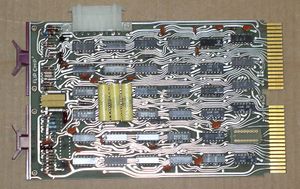KL11 Teletype Control
The KL11 Teletype Control card (M780) was a UNIBUS peripheral for the PDP-11 series of computers; it provided a single asynchronous serial line. It was a dual format card; it plugged into a an SPC slot, along with two standard single card FLIP CHIPs, the M105 Address Selector and the M782 Interrupt Control.
The KL11 was one of the last DEC asynchronous serial interfaces to not use a UART MSI chip; the first UART chip was still under development at the time. The serial/parallel conversion was done with discrete gates, instead.
It provided a 20mA current loop serial line interface; use of a DE11A allowed EIA RS-232 connectivity. It operated at speeds of 110 to 2400 baud, depending on the model (each model supported only one speed combination):
| Model | Input | Output |
|---|---|---|
| KL11A | 110 | |
| KL11B | 150 | |
| KL11C | 300 | |
| KL11D | 600 | |
| KL11E | 100 | 1200 |
| KL11F | 2400 | |
It was replaced by the functionally identical single quad board DL11 asynchronous serial line interface.
Programing interface
The KL11 has 2 device registers for the receive side (one Control and Status Register - CSR - and one data buffer register), and similarly, two for the transmit side. Each KL11 has two interrupt vectors - again, one receive, and one transmit. This programming specification was continued for the lifetime of the PDP-11, for single asynchronous serial line interfaces.
For the PDP-11 main console (which is always a KL11/DL11 compatible device), the 'zeroth' KL11, the standard is that 0777560 is the base address (so the receiver registers are 0777560-2, and the transmitter are 0777564-6), and 060 is the base vector.
The first KL11 after the console is always assigned the address 0776500, and vector 0300. Additional KL11's are assigned addresses and vectors immediately following, for LL11's #1-#16 (i.e. 0776500-676 and 0300-0476).
External links
- KL11 teletype control manual (DEC-11-HR4C-D)
- KL11 teletype control engineering drawings (DEC-11-HR4B-D)
